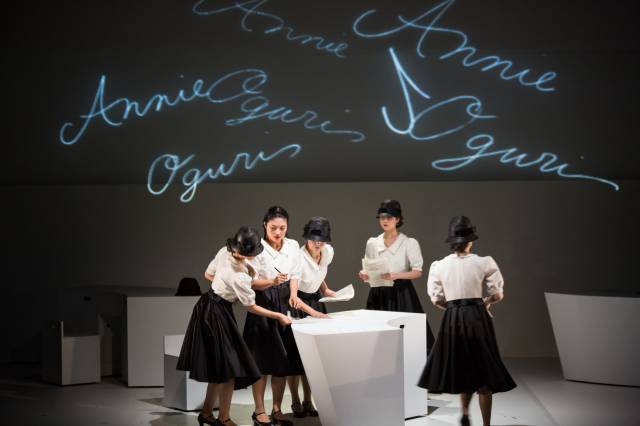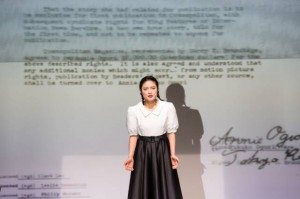

As the world marks the 70th anniversary of the end of WWII, New York audiences are given a gift in Miwa Yanagi’s visually splendid theater piece, Zero Hour: Tokyo Rose’s Last Tape, which opens the Japan Society’s series Stories from the War. Using as the centerpiece the mystery surrounding the identity of the infamous female voice of propagandist Tokyo Rose, Ms. Yanagi propels us back to wartime in the South Pacific.
Zero Hour, a 75-minute radio show broadcast from the state-run Radio Tokyo, was propaganda intended to demoralize the Allied Forces, filled with slanted commentary delivered by a female announcer called 'Tokyo Rose' by American soldiers who loved the sultry voiced broadcaster. In fact, 'Tokyo Rose' was not a single woman, but multiple young Japanese-American women who were stranded in Japan when the war broke out and ordered to work as radio announcers. Yet after the war, the moniker was linked to one Japanese-American woman in particular, Iva Toguri, who was tried and convicted of treason by the U.S. In Zero Hour, Toguri is loosely embodied in the character Annie Yukuko Oguri Moreno, played to perfection by Hinako Arao.

Ms. Yanagi is a world renowned visual artist and she brings her extraordinary eye to every detail of this stunning production. A brilliant set consists of white modular crescents that glide across the stage to create a variety of settings and shapes. Ms. Yanagi dresses the five young Tokyo Roses in identical costumes designed by Yukari Asakura; school girlish uniforms and low brimmed cloche hats that obscure each one’s individuality. Ms. Yanagi sculpts stylized gestures and movement patterns that reflect precise emotional moments as the young women, following orders and doing as they are told, begin as typists and are drafted into being announcers for the Zero Hour program, each being given an American name and encouraged to adopt a Western personality.
In addition to Ms. Arao, the other four Tokyo Roses, Sachi Masuda, Megumi Matsumoto, Aki and Ami Kobayashi, perform their roles with exactitude and vulnerability. Especially noteworthy is Ms. Kobayashi’s portrayal of silver-voiced Jane as she trains the inexperienced women to be broadcasters. In counterpoint to the young women are Zero Hour’s two male characters, Toshiya Shiomi (Sogo Nishimura), the Radio Tokyo manager, and Daniel Yamada (Yohei Matsukado), a Japanese-American soldier searching for the Tokyo Rose. Both Mr. Matsukado and Ms. Nishimura deliver fine performances, especially in an interrogation scene.
At two hours without an intermission, the middle portion of Zero Hour lags; although always interesting to watch, cuts could be made to move the story to its fascinating conclusion with brevity.